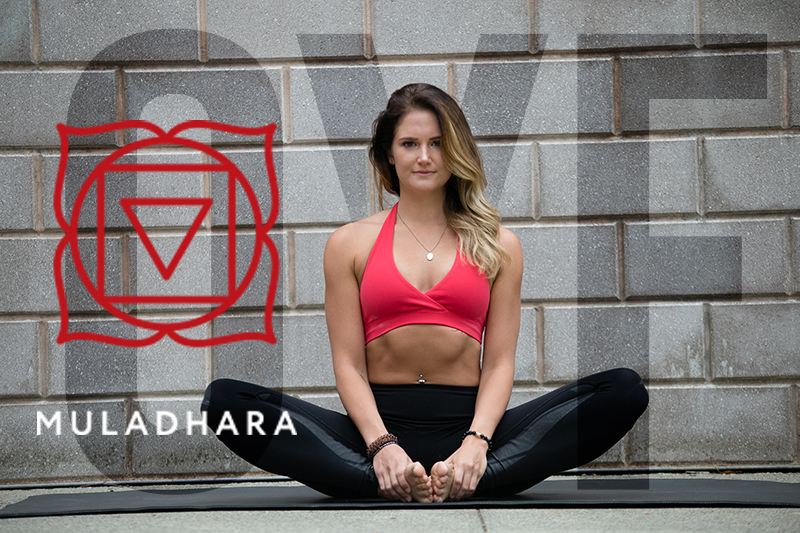How to focus on staying grounded in your yoga practice for your root Chakra.
If you’re leading a health conscious life, odds are you’ve spent a fair amount of time considering how best to take care of your physical and mental health. But, have you considered what role your energy play in your wellbeing? Our energy can have an effect on our lives in many ways, whether it be feeling too tired to put our best foot forward, or whether it be the energy we’re projecting when we step into a room to meet new people.
You might come to yoga class to refresh your energy. Even if this wasn’t your main motivation for showing up to class, you might find yourself thinking about what energy you are bringing with you as you step onto your mat. You might also think about how your body feels as you step on the mat, or what’s going on in your mind. As you delve deeper into your yoga practice, you’ll likely hear energy spoken about as related to chakras, and you might find that between each of these chakras, you’ll address each of these things.
What is a chakra?
The concept of chakras can be traced back to before the common era, where they were found in spiritual texts called the Vedas. In yoga practice, focusing on your chakras is an important way to consider where your energy is gathering. The chakras are thought to be another layer of your body than the physical, where your “life force energy”, also known as the “prana”, gathers as it travels through what is referred to as “the subtle body”. As explained by Healthline, the chakras are only one part of a “nuanced spiritual and religious tradition”. While the chakras might be only one part of a larger tradition, they are also thought to connect to many parts of our mind, our body, and our energy.
There are often considered to be seven main chakras within our body, each relating to specific parts of our bodies, minds, and lives. One of these seven chakras is the root chakra, or Muladhara. If you’re unfamiliar with the chakras, but interested in learning more, learning about the root chakra could be a good place to start, because it is sometimes considered the base which supports of the rest of the chakras. As explained by Michelle Fondin for Chopra “balancing the root chakra creates the solid foundation for opening the chakras above”. So, what is this root chakra, and how can you create the strongest possible foundation for the rest of the chakras?
What is the root chakra?
Much like the name suggests, the root chakra is related to the things that ground you in life. In times such as these, which we’ve all heard described as unprecedented more times than we can count, many of us could likely use some grounding in our lives. Also in line with the theme of roots, the natural element associated with the root chakra is the earth. This chakra is found at the base of the spine, by the pelvic floor and the first three vertebrae. Fondin explains this chakra as being “responsible for your sense of safety and security”. So, when our root chakra is balanced, this correlates with us feeling safe and stable. Stability is an ongoing focus when discussing the root chakra, for example Yoga International shares the root chakra affirmation ““I am connected to the earth. I am strong and I am stable””.
Apart from the sense of stability, when your root chakra is balanced, benefits are believes to include improved focus, greater dependability, and a greater connection with oneself, to name a few. When your root chakra is not balanced then, you might feel somewhat the opposite – whether this be feeling distracted, stressed, or stuck. There’s also thought to be physical affects of a lack of blocked root chakra, including lower back or leg and feet problems.
Balancing the root chakra
If you’ve been feeling unstable or out of balance lately, or if you simply want to consider what aspects of your yoga practice are connecting you to your root chakra, there are specific practices and asanas that you may want to focus on. You might want to focus on grounding meditations. Fondin also suggests specific poses such as the knee to chest pose and the squatting pose. In general, a focus on poses and flows which “strenghten the legs, feet, and pelvic floor” are considered a way to connect with the root chakra. You can find practices specifically designed for the root chakra, such as Yoga Journal’s “Root Chakra Tune-Up Practice”.
In addition to yoga, activities which are thought to help us root ourselves include walking outside, gardening, and dance, so if you’re focusing on your root chakra you might want to consider melding some of these workouts into your weekly routine as well. Next time you come into a yoga class, ask your instructor about what classes might be best suited to a focus on your root chakra, or you can work poses which support balancing the root chakra into your independent practice between classes.

